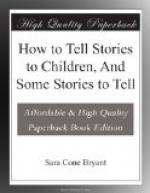My three-year-old niece, who had not seen me since her babyhood, being told that Aunt Sara was coming to visit her, somehow confused the expected guest with a more familiar aunt, my sister. At sight of me, her rush of welcome relapsed into a puzzled and hurt withdrawal, which yielded to no explanations or proffers of affection. All the first day she followed me about at a wistful distance, watching me as if I might at any moment turn into the well-known and beloved relative I ought to have been. Even by undressing time I had not progressed far enough to be allowed intimate approach to small sacred nightgowns and diminutive shirts. The next morning, when I opened the door of the nursery where her maid was brushing her hair, the same dignity radiated from the little round figure perched on its high chair, the same almost hostile shyness gazed at me from the great expressive eyes. Obviously, it was time for something to be done.
Disregarding my lack of invitation, I drew up a stool, and seating myself opposite the small unbending person, began in a conversational murmur: “M—m, I guess those are tingly-tanglies up there in that curl Lottie’s combing; did you ever hear about the tingly-tanglies? They live in little girls’ hair, and they aren’t any bigger than that, and when anybody tries to comb the hair they curl both weeny legs round, so, and hold on tight with both weeny hands, so, and won’t let go!” As I paused, my niece made a queer little sound indicative of query battling with reserve. I pursued the subject: “They like best to live right over a little girl’s ear, or down in her neck, because it is easier to hang on, there; tingly-tanglies are very smart, indeed.”
“What’s ti-ly-ta-lies?” asked a curious, guttural little voice.
I explained the nature and genesis of tingly-tanglies, as revealed to me some decades before by my inventive mother, and proceeded to develop their simple adventures. When next I paused the small guttural voice demanded, “Say more,” and I joyously obeyed.
When the curls were all curled and the last little button buttoned, my baby niece climbed hastily down from her chair, and deliberately up into my lap. With a caress rare to her habit she spoke my name, slowly and tentatively, “An-ty Sai-ry?” Then, in an assured tone, “Anty Sairy, I love you so much I don’t know what to do!” And, presently, tucking a confiding hand in mine to lead me to breakfast, she explained sweetly, “I didn’ know you when you comed las’ night, but now I know you all th’ time!”
“Oh, blessed tale,” thought I, “so easy a passport to a confidence so desired, so complete!” Never had the witchery of the story to the ear of a child come more closely home to me. But the fact of the witchery was no new experience. The surrender of the natural child to the story-teller is as absolute and invariable as that of a devotee to the priest of his own sect.




